
Wine Culture and Information since 2002 - Volume 22
 Wine Culture and Information since 2002 - Volume 22 |
|
Contrasts of Vittoria Frappato and Romagna SangioveseSicily and Emilia-Romagna are compared in the glasses of this month's tasting by contrast with two wines and two grapes that strongly identify their respective territories. |
|
When we talk about red wine in the eastern part of Emilia-Romagna, Italy, it is practically impossible not to have a Sangiovese in the glass. This grape, in fact, has a very strong bond with this territory and in which it has been cultivated since time immemorial. Imagining to move to Sicily and, in particular, to Vittoria – in the province of Ragusa – wanting to talk about wine, the most obvious association is certainly Cerasuolo di Vittoria, however, speaking of grapes, they would be Nero d'Avola and Frappato. These are two very different territories, with equally diverse histories and wine cultures, not least with decidedly distant environmental and climatic conditions. Even the two grapes that we are going to examine in the tasting by contrast are, in fact, different and distant, as can be easily found out from the sensorial evaluation of the respective wines. Both grapes share an uncertain origin, and – over time – various assumptions have been made which, even today, are not fully confirmed. Emilia-Romagna and Sicily are regions having a large surface area reserved to agricultural activities, including viticulture. In the vineyards of these two regions we find a rich variety of grapes, both native and non-native of French origin. This diversity, no less, has also led to the definition of many areas with Denominazione d'Origine (Denomination of Origin) – in both regions there are more than twenty – in which wines are produced with both native grapes and so-called “international”. This month we will compare two wines produced in the Denominazione d'Origine Controllata (Denomination of Controlled Origin, DOC) territories of Sicily and Emilia-Romagna, produced with grapes which – undoubtedly – are among the most significant and representative ones in their respective regions. We will in fact compare the Frappato produced in Vittoria and the Sangiovese of Romagna, grapes and territories capable of giving their respective wines character and personality, with distinct and different sensorial and enological qualities, perfect for the goal of our tasting by contrast.
|
|
Vittoria – in the province of Ragusa, in the southern part of Sicily – is the only wine-growing area in the region to have a Denominazione d'Origine Controllata e Garantita rank (Denomination of Controlled and Guaranteed Origin, DOCG) attributed to Cerasuolo di Vittoria wine. This important Sicilian red wine is mainly produced with Nero d'Avola grape and the remaining part of Frappato, the variety that we will examine in this month's tasting. In the same territory – which covers the territories belonging to the provinces of Ragusa, Caltanissetta and Catania – the territory of Denominazione d'Origine Controllata Vittoria is also defined, in which is allowed the production of white and red wines, including mono-varietal ones. This is the case of the wine that we are going to evaluate in this month's tasting – Vittoria Frappato – for which, the relative production disciplinary, just like the majority of the Italian “mono-varietal” DOC wines, is produced with at least 85% of this variety. Frappato is a grape of important enological and sensorial interest, capable of giving personality and identity to its wines. Of very ancient origins and, although it is considered an indigenous variety of Sicily, more precisely of Vittoria, it is actually believed to originate from the Iberian peninsula. Frappato, in Sicily, however has a rather limited diffusion, mainly in the provinces of Ragusa and Siracusa, particularly in the territory of Vittoria. The character of the wines produced with Frappato mainly express fruity aromas, in particular red pulp fruits, of pleasing finesse and elegance, often characterized by the spicy scent of black pepper. In order to favor the fresh and fruity expression of Frappato, producers generally tend to vinify it in inert containers, whereas when it is blended to other varieties – as in the case of Nero d'Avola for the production of Cerasuolo di Vittoria wine – the aging in wood is more frequent.
|
||||
|
When red wines of Romagna – the eastern part of the region – are concerned, the primary reference is unquestionably Sangiovese. This famous red grape variety, among the most cultivated and widespread in Italy, especially in the Center, clearly and decisively identifies this land too and since a very long time. It is no coincidence, in fact, that among the many theories and legends linked to the origin of the Sangiovese grape, one leads back to Romagna and, in particular, to the town of Santarcangelo, more precisely, to the nearby Mount Giove or Colli Jovis and from which, as the legend goes on, it takes its name. Today, thanks to specific genetic research conducted on this grape, it is believed that Sangiovese actually derives from some varieties of southern Italy and that, for a long time, it has found in the Tuscany-Romagna Apennines its ideal and identifying territory. In fact, it was in this area that it will take its name: on the Tuscan side it becomes known as Sangioveto, while in Romagna it is known as uva sanzuvesa, more properly, Sangiovese. Sangiovese in Romagna is a grape of primary enological importance, with a long and consolidated history, so much so that it was among the first ones to obtain, in this land, the rank of Denominazione d'Origine Controllata. In 1967, in fact, Sangiovese di Romagna DOC was established, a name by which it will be known and appreciated until 2011, when the denomination becomes part of the more “generic” Romagna DOC. Specifically, Romagna Sangiovese can be produced in certain territories of the provinces of Forlì-Cesena, Ravenna, Rimini and Bologna. With the aim of better identifying the expressions of Sangiovese in this vast territory – as well as other varieties – the Romagna denomination also includes the following sub-areas: Bertinoro, Brisighella, Castrocaro and Terra del Sole, Cesena, Longiano, Marzeno, Meldola, Modigliana, Oriolo, Predappio, San Vicinio and Serra. Romagna Sangiovese, of which the “riserva” style is also produced, is usually vinified in wood casks, a technique that is more widely used than the use of inert containers, such as steel tanks.
|
Our tasting by contrast will focus on the study of the specific qualities of Vittoria Frappato and Romagna Sangiovese, therefore, when choosing the bottles of wines that we will pour into the glasses, we need to pay attention to their production methods. Specifically, we will get wines exclusively produced with fermentation and aging in inert containers, preferably the steel tank. As usually happens with Italian Denominazione d'Origine Controllata wines requiring the indication of the variety in the label, we will pay attention to the composition as both Vittoria Frappato and Romagna Sangiovese allow the use of a part made of other grapes in addition to primary one. As the main purpose of our tasting by contrast is to understand and detect the specific differences of Frappato and Sangiovese, the respective bottles belong to the most recent harvest. The two wines are poured into tasting glasses at a temperature of 17° C. (63 °F) We can now pour the two wines into their glasses and begin this month's tasting by contrast, starting with Vittoria Frappato. By tilting the glass over a white surface and – by observing the base – we evaluate the color. The Sicilian wine presents itself to the eye with a brilliant ruby red color and, by placing a contrasting object between the glass and the white surface, a moderate transparency is revealed. Let's now observe the wine towards the opening of the glass, where the thickness becomes thinner, therefore evaluating the nuance. Also in this case a brilliant ruby red color is observed. Let's now move on to the evaluation of Romagna Sangiovese, therefore, tilting the glass over the white surface, and evaluate the color by observing the wine at the base. We can see a brilliant ruby red color, with a moderate transparency, generally lower than that of Vittoria Frappato. We then observe the nuances of the wine – towards the opening of the glass – in which the ruby red base color is confirmed. The olfactory profiles of Vittoria Frappato and Romagna Sangiovese, when vinified in inert containers, are appreciated for the pleasing aromas of red and black pulp fruits, as well as flowers. The profiles, although sharing common scents, develop and express completely different qualities and intensities. Furthermore, Frappato can develop a certain spicy profile – completely absent in wines produced with Sangiovese – and in which black pepper can be recognized. The wines produced with Frappato, in particular those of Vittoria DOC, can be recognized to the nose for their aromas of cherry, strawberry and raspberry, as well as the pleasing floral sensation reminiscent of rose and cyclamen. As already mentioned, in wines produced with this grape, it can be very often perceived a spicy character directly reminiscent of black pepper. The wines produced with Sangiovese, in this case, those of the Romagna denomination, are appreciated for the pleasing aromas of black cherry, plum, raspberry and blueberry, whereas for the aromas belonging to the world of flowers, the main perceptions are violet, rose and the geranium. Let's resume the tasting of our wines, proceeding with the evaluation of their respective olfactory profiles. The first wine we examine – as in the first phase – is Vittoria Frappato. By holding the glass in vertical position and without swirling, let's proceed with the first smell in order to evaluate the opening of the Sicilian wine. From the glass we can perceive clear and intense aromas of cherry, strawberry and raspberry followed by the unmistakable floral scent of rose. Let's now swirl the glass, so as to favor the development of the other aromas, and proceed with the second smell. The profile of this wine is completed with blueberry and blackberry, as well as the aromas of cyclamen and, frequently, black pepper. Let's now move on to the evaluation of the olfactory profile of Romagna Sangiovese and proceed to the analysis of its opening. From the glass we perceive, clear and intense, the aromas of black cherry, plum and violet, three sensations that very often distinguish wines produced with Sangiovese. After having swirled the glass and carried out the second smell, the profile of the wine is completed with blueberry, raspberry, strawberry and the floral scent of rose. Let's now move on to the evaluation of the gustatory profiles of the two wines of our tasting by contrast, starting – as in the previous phases – from Vittoria Frappato. Let's proceed with the evaluation of its attack, that is, the identifying and primary sensations that are perceived in the mouth at the first sip. The wine is characterized by a moderate astringency, well supported by the pleasing crispness given by the acidity, both balanced by the effect of the alcohol and the pleasing roundness. The body of Vittoria Frappato is good, however it is the crispness to mainly characterize the wine. Let's now examine the taste profile of Romagna Sangiovese, therefore take the first sip in order to evaluate its attack. The first sensation we perceive in the mouth is the moderate astringency – generally more intense than Frappato – which immediately finds balance thanks to the effect of alcohol. In addition to the good body, a pleasing crispness is also perceived in the mouth, a quality that is often evident in Sangiovese when it is vinified in inert containers. Let's proceed with the last phase of this month's tasting, therefore evaluate the final sensations the two wines leave in the mouth after swallowing, in particular, the so-called taste-olfactory persistence. The finish of Vittoria Frappato is persistent and in the mouth we can continue to clearly perceive the flavors of cherry, strawberry and raspberry, in addition to the moderate astringency combining with the crispness of the wine. The finish of Romagna Sangiovese is also persistent, leaving in the mouth the sensation of moderate astringency – generally more accentuated than Frappato – in addition to the good body and the typical sensation of crispness. In the mouth we can continue to perceive the flavors of black cherry, plum and blueberry, often raspberry as well. Now compare the difference in the effect of astringency and crispness the two wines leave in the mouth in the final phase. Finally, by placing the glasses close together, we carry out the final smell – first Vittoria Frappato and then Romagna Sangiovese – which further allows us to perceive and understand the differences in the respective olfactory profiles.
|
||||||||
Wines of the Month |
|
|
|
Score legend Prices are to be considered as indicative. Prices may vary according to the country or the shop where wines are bought |

|
|
Vermentino di Gallura Superiore Sciala 2022 |
|
| Surrau (Sardinia, Italy) | |
 Vermentino Vermentino | |
| Price: € 21.00 | Score: |
 Brilliant straw yellow and nuances of straw yellow, very transparent. Brilliant straw yellow and nuances of straw yellow, very transparent. Intense, clean, pleasing, refined and elegant, starts with hints of
apple, pear and peach followed by aromas of hawthorn, broom, plum,
pineapple, grapefruit, medlar, tangerine, almond and mineral. Intense, clean, pleasing, refined and elegant, starts with hints of
apple, pear and peach followed by aromas of hawthorn, broom, plum,
pineapple, grapefruit, medlar, tangerine, almond and mineral.
 Crisp attack and however balanced by alcohol, good body, intense
flavors, pleasing roundness. Crisp attack and however balanced by alcohol, good body, intense
flavors, pleasing roundness.
 Persistent finish with flavors of apple, pear and peach. Persistent finish with flavors of apple, pear and peach. 4 months in steel tanks. 4 months in steel tanks. |
|
 Pasta with fish, Stewed fish, Stewed white meat, Legume soups, Mushroom soups Pasta with fish, Stewed fish, Stewed white meat, Legume soups, Mushroom soups |
|

|
|
Vermentino di Gallura Vendemmia Tardiva Montidimola 2021 |
|
| Surrau (Sardinia, Italy) | |
 Vermentino Vermentino | |
| Price: € 32.00 | Score: |
 Brilliant straw yellow and nuances of golden yellow, very transparent. Brilliant straw yellow and nuances of golden yellow, very transparent. Intense, clean, pleasing, refined and elegant, starts with hints of
apple, plum and peach followed by aromas of hawthorn, mango, pineapple,
citron, pear, grapefruit, caper, thyme, almond, mineral and hints of
vanilla. Intense, clean, pleasing, refined and elegant, starts with hints of
apple, plum and peach followed by aromas of hawthorn, mango, pineapple,
citron, pear, grapefruit, caper, thyme, almond, mineral and hints of
vanilla.
 Crisp attack and however balanced by alcohol, good body, intense
flavors, pleasing roundness. Crisp attack and however balanced by alcohol, good body, intense
flavors, pleasing roundness.
 Very persistent finish with long flavors of apple, plum and almond. Very persistent finish with long flavors of apple, plum and almond. Part of the wine is fermented in cask. 6 months in cask and cement
tanks, 12 months in bottle. Part of the wine is fermented in cask. 6 months in cask and cement
tanks, 12 months in bottle.
|
|
 Stuffed pasta with mushrooms and fish, Roasted white meat, Roasted fish, Legume soups, Fish soups Stuffed pasta with mushrooms and fish, Roasted white meat, Roasted fish, Legume soups, Fish soups |
|

|
|
Bacco 2021 |
|
| Siddura (Sardinia, Italy) | |
 Carignano Carignano | |
| Price: € 23.00 | Score: |
 Intense ruby red and nuances of ruby red, little transparency. Intense ruby red and nuances of ruby red, little transparency. Intense, clean, pleasing, refined and elegant, starts with hints of
black cherry, plum and blueberry followed by aromas of violet, carnation,
blackberry, arbutus berry, carob, myrtle, juniper, rosemary and vanilla. Intense, clean, pleasing, refined and elegant, starts with hints of
black cherry, plum and blueberry followed by aromas of violet, carnation,
blackberry, arbutus berry, carob, myrtle, juniper, rosemary and vanilla.
 Properly tannic attack and however balanced by alcohol, good body,
intense flavors, agreeable. Properly tannic attack and however balanced by alcohol, good body,
intense flavors, agreeable.
 Persistent finish with flavors of black cherry, plum and blueberry. Persistent finish with flavors of black cherry, plum and blueberry. 12 months in cask. 12 months in cask. |
|
 Broiled meat and barbecue, Roasted meat, Stewed meat with mushrooms, Cheese Broiled meat and barbecue, Roasted meat, Stewed meat with mushrooms, Cheese |
|

|
|
Moscato di Sardegna Passito Nuali 2021 |
|
| Siddura (Sardinia, Italy) | |
 Moscato Bianco Moscato Bianco | |
| Price: € 22.95 - 375ml | Score: |
 Brilliant amber yellow and nuances of amber yellow, transparent. Brilliant amber yellow and nuances of amber yellow, transparent. Intense, clean, pleasing, refined and elegant, starts with hints of
grape, dried apricot and date followed by aromas of dried fig, quince jam
peach jam, lychee, citrus fruit peel, lavender, honey, candied fruits,
thyme and nail polish. Intense, clean, pleasing, refined and elegant, starts with hints of
grape, dried apricot and date followed by aromas of dried fig, quince jam
peach jam, lychee, citrus fruit peel, lavender, honey, candied fruits,
thyme and nail polish.
 Sweet and round attack, however balanced by alcohol, good body,
intense flavors, pleasing crispness. Sweet and round attack, however balanced by alcohol, good body,
intense flavors, pleasing crispness.
 Persistent finish with flavors of grape, dried apricot and date. Persistent finish with flavors of grape, dried apricot and date. Aged in steel tanks. Aged in steel tanks. |
|
 Dried fruit and jam tarts, Confectionery, Piquant cheese Dried fruit and jam tarts, Confectionery, Piquant cheese |
|
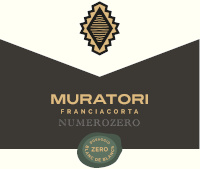
|
|
Franciacorta Dosaggio Zero Blanc de Blancs NumeroZero |
|
| Muratori (Lombardy, Italy) | |
 Chardonnay Chardonnay | |
| Price: € 29.00 | Score: |
 Pale straw yellow and nuances of greenish yellow, very transparent,
fine and persistent perlage. Pale straw yellow and nuances of greenish yellow, very transparent,
fine and persistent perlage.
 Intense, clean, pleasing and refined, starts with hints of banana, pera
and acacia followed by aromas of hawthorn, citron, apple, medlar, peach,
hazelnut and yeast. Intense, clean, pleasing and refined, starts with hints of banana, pera
and acacia followed by aromas of hawthorn, citron, apple, medlar, peach,
hazelnut and yeast.
 Effervescent and crisp attack, however balanced by alcohol, good body,
intense flavors, agreeable. Effervescent and crisp attack, however balanced by alcohol, good body,
intense flavors, agreeable.
 Persistent finish with flavors of banana, pear and citron. Persistent finish with flavors of banana, pear and citron. Refermented in bottle and aged on its lees for at least 24 months. Refermented in bottle and aged on its lees for at least 24 months. |
|
 Pasta and risotto with crustaceans and fish, Sauteed crustaceans, Sauteed fish, Dairy products, Vegetable flans Pasta and risotto with crustaceans and fish, Sauteed crustaceans, Sauteed fish, Dairy products, Vegetable flans |
|
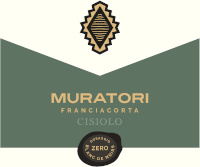
|
|
Franciacorta Dosaggio Zero Blanc de Noirs Cisiolo |
|
| Muratori (Lombardy, Italy) | |
 Pinot Nero Pinot Nero | |
| Price: € 29.00 | Score: |
 Brilliant straw yellow and nuances of straw yellow, very transparent,
fine and persistent perlage. Brilliant straw yellow and nuances of straw yellow, very transparent,
fine and persistent perlage.
 Intense, clean, pleasing and refined, starts with hints of plum, pink
grapefruit and bread crust followed by aromas of hawthorn, tangerine,
raspberry, pineapple, apple, praline, honey and hazelnut. Intense, clean, pleasing and refined, starts with hints of plum, pink
grapefruit and bread crust followed by aromas of hawthorn, tangerine,
raspberry, pineapple, apple, praline, honey and hazelnut.
 Effervescent and crisp attack, however balanced by alcohol, good body,
intense flavors, agreeable. Effervescent and crisp attack, however balanced by alcohol, good body,
intense flavors, agreeable.
 Persistent flavors with flavors of plum, pink grapefruit and tangerine. Persistent flavors with flavors of plum, pink grapefruit and tangerine. Refermented in bottle and aged on its lees for at least 18 months. Refermented in bottle and aged on its lees for at least 18 months. |
|
 Pasta and risotto with fish, Sauteed white meat, Fish soups, Sauteed fish Pasta and risotto with fish, Sauteed white meat, Fish soups, Sauteed fish |
|
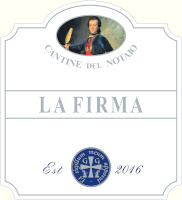
|
|
Aglianico del Vulture La Firma 2016 |
|
| Cantine del Notaio (Basilicata, Italy) | |
 Aglianico Aglianico | |
| Price: € 36.00 | Score: |
 Deep ruby red and nuances of garnet red, little transparency. Deep ruby red and nuances of garnet red, little transparency. Intense, clean, pleasing, refined and elegant, starts with hints of
plum, blackberry and black cherry followed by aromas of dried violet,
blueberry, raspberry, carob, cocoa, cinnamon, tobacco, mace, licorice,
leather, vanilla and menthol. Intense, clean, pleasing, refined and elegant, starts with hints of
plum, blackberry and black cherry followed by aromas of dried violet,
blueberry, raspberry, carob, cocoa, cinnamon, tobacco, mace, licorice,
leather, vanilla and menthol.
 Properly tannic attack and however balanced by alcohol, full body,
intense flavors, agreeable. Properly tannic attack and however balanced by alcohol, full body,
intense flavors, agreeable.
 Very persistent finish with long flavors of plum, blackberry and black
cherry. Very persistent finish with long flavors of plum, blackberry and black
cherry.
 At least 12 months in barrique, 12 months in bottle. At least 12 months in barrique, 12 months in bottle. |
|
 Game, Roasted meat, Braised and stewed meat, Hard cheese Game, Roasted meat, Braised and stewed meat, Hard cheese |
|
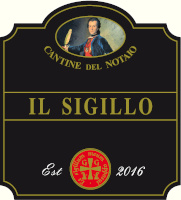
|
|
Aglianico del Vulture Il Sigillo 2016 |
|
| Cantine del Notaio (Basilicata, Italy) | |
 Aglianico Aglianico | |
| Price: € 39.90 | Score: |
 Deep ruby red and nuances of garnet red, little transparency. Deep ruby red and nuances of garnet red, little transparency. Intense, clean, pleasing, refined and elegant, starts with hints of
black cherry, blackberry and plum followed by aromas of dried violet, iris,
blueberry, cocoa, carob, tobacco, face powder, mace, licorice, leather,
vanilla and menthol. Intense, clean, pleasing, refined and elegant, starts with hints of
black cherry, blackberry and plum followed by aromas of dried violet, iris,
blueberry, cocoa, carob, tobacco, face powder, mace, licorice, leather,
vanilla and menthol.
 Properly tannic attack and however balanced by alcohol, full body,
intense flavors, pleasing roundness. Properly tannic attack and however balanced by alcohol, full body,
intense flavors, pleasing roundness.
 Very persistent finish with long flavors of black cherry, blackberry
and plum. Very persistent finish with long flavors of black cherry, blackberry
and plum.
 At least 24 months in cask and barrique, 12 months in bottle. At least 24 months in cask and barrique, 12 months in bottle. |
|
 Game, Roasted meat, Braised and stewed meat, Hard cheese Game, Roasted meat, Braised and stewed meat, Hard cheese |
|
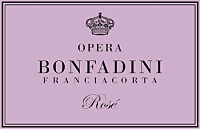
|
|
Franciacorta Rosé Brut Opera |
|
| Bonfadini (Lombardy, Italy) | |
 Chardonnay (50%), Pinot Nero (50%) Chardonnay (50%), Pinot Nero (50%) | |
| Price: € 21.00 | Score: |
 Intense pale pink and nuances of pale pink, transparent, fine and
persistent perlage. Intense pale pink and nuances of pale pink, transparent, fine and
persistent perlage.
 Intense, clean, pleasing and refined, starts with hints of cherry,
raspberry and bread crust followed by aromas of cyclamen, arbutus berry,
tangerine, strawberry, apple, plum, pink grapefruit and hints of vanilla. Intense, clean, pleasing and refined, starts with hints of cherry,
raspberry and bread crust followed by aromas of cyclamen, arbutus berry,
tangerine, strawberry, apple, plum, pink grapefruit and hints of vanilla.
 Effervescent and crisp attack, however balanced by alcohol, good body,
intense flavors, agreeable. Effervescent and crisp attack, however balanced by alcohol, good body,
intense flavors, agreeable.
 Persistent finish with flavors of cherry, raspberry and arbutus berry. Persistent finish with flavors of cherry, raspberry and arbutus berry. Part of the Pinot Noir is fermented and aged in barrique for 7 months.
Refermented in bottle and aged on its lees for at least 24 months. Part of the Pinot Noir is fermented and aged in barrique for 7 months.
Refermented in bottle and aged on its lees for at least 24 months.
|
|
 Pasta with meat, Roasted white meat, Stewed fish with mushrooms, Legume soups, Dairy products Pasta with meat, Roasted white meat, Stewed fish with mushrooms, Legume soups, Dairy products |
|
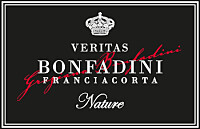
|
|
Franciacorta Nature Veritas |
|
| Bonfadini (Lombardy, Italy) | |
 Chardonnay (90%), Pinot Nero (10%) Chardonnay (90%), Pinot Nero (10%) | |
| Price: € 23.50 | Score: |
 Brilliant straw yellow and nuances of straw yellow, very transparent,
fine and persistent perlage. Brilliant straw yellow and nuances of straw yellow, very transparent,
fine and persistent perlage.
 Intense, clean, pleasing and refined, starts with hints of apple, plum
and bread crust followed by aromas of hawthorn, banana, grapefruit, butter,
praline, honey and hints of vanilla. Intense, clean, pleasing and refined, starts with hints of apple, plum
and bread crust followed by aromas of hawthorn, banana, grapefruit, butter,
praline, honey and hints of vanilla.
 Effervescent and crisp attack, however balanced by alcohol, good body,
intense flavors, agreeable. Effervescent and crisp attack, however balanced by alcohol, good body,
intense flavors, agreeable.
 Persistent finish with flavors of apple, plum and honey. Persistent finish with flavors of apple, plum and honey. Part of the Chardonnay is fermented and aged in barrique for 7 months.
Refermented in bottle and aged on its lees for at least 30 months. Part of the Chardonnay is fermented and aged in barrique for 7 months.
Refermented in bottle and aged on its lees for at least 30 months.
|
|
 Pasta and risotto with fish, Sauteed white meat, Fish soups, Sauteed fish Pasta and risotto with fish, Sauteed white meat, Fish soups, Sauteed fish |
|
|
||||||||
|
DiWineTaste Polls
|
| |||||||
Privacy Policy | |||||||


| Copyright © 2002-2024 Antonello Biancalana, DiWineTaste - All rights reserved |
| All rights reserved under international copyright conventions. No part of this publication and of this WEB site may be
reproduced or utilized in any form or by any means, electronic or mechanical, without permission in writing from DiWineTaste. |